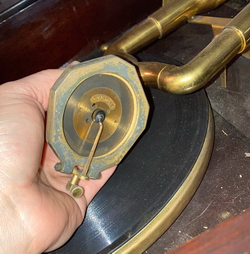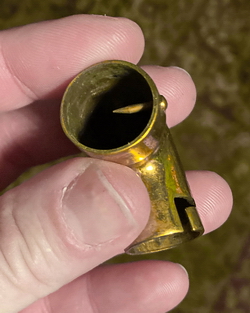|
Dual-Tone Phonograph, Revisited
by Bill Pratt
Daniel Toscano's Dual-Tone phonograph

|
|
Photographs courtesy of Daniel Toscano
In the November-December 2012 issue of Antique Phonograph News, also posted online at << https://capsnews.org/apn2012-6.htm >>, CAPS member Jim Carino published an article highlighting three off-brand phonographs in his collection. Chief among these was the Dual-Tone phonograph which was manufactured by the Dual-Tone Phonograph & Mfg. Co. of Manor, Pennsylvania and marketed as "the King of Phonographs".
The Dual-Tone is a disc-playing talking machine that was sold with either an upright or a console-style cabinet. It plays both lateral- and vertical-cut records. The distinguishing feature of the Dual-Tone is its tone arm which branches from its mount on the motor board into two arms or passages which then combine into a single arm to hold a single reproducer.
A patent for the tone arm design, US Patent 1516603A, was filed on November 12, 1919 and granted on November 25, 1924. (1) The description reads in part:
Our invention relates to sound reproducing devices and consists of phonograph parts adapted to develop and deliver sound waves from the usual sound records more efficiently and with better tonal results than similar parts previously used.
One of the defects of present phonographs is their inability to reproduce all of the sounds recorded and their faulty reproduction and amplification of the tones of the sounds which they do yield. The object of our invention is to eliminate these defects and we attain our objective by manufacturing phonograph reproducing and developing parts of a material hitherto unused for that purpose and by providing otherwise improved passages through which the sound waves travel to the atmosphere.
The use of a double tone arm gives remarkable results in the tonal qualities of the sounds reproduced. By substituting our arm for a single arm we have obtained from the same record and with the same sound box, not only better tones for all sounds, but even some sounds not previously audible.
Dual-Tone reproducer

|
|
The "material hitherto unused" for the construction of the tone arm was a phenolic condensation product such as bakelite. The benefit of the double tone arm design, according to the patent description, was that each sound wave created at the reproducer generated duplicate sound waves which travelled through both passages and then united into a single enhanced wave which proceeded through the base and out the internal horn.
The Dual-Tone also featured an "improved reproducer" in the shape of a 10-sided polygon with clipped corners. The patent for the reproducer, US Patent 1392677A, was filed on August 27, 1919 and granted on October 4, 1921. (2) The claim to originality of the reproducer was that supplementary sounding plates, in addition to the usual vibrating disk, and multiple sound control apertures amplified the sound and "reproduced the various tones whose vibrations have been recorded in the disk record in true form and condition and without the screeching and unpleasant sounds or noise at present frequently produced by the reproducers in use".
In his article, Jim observed that the two parallel arms on the tone arm and the decagon-shaped reproducer did not affect the tonal sound at all. He concluded that it was likely just an attempt to get around the Victor tone arm patent. Jim also noted that the tone arm on his Dual-Tone was made of gold-plated pot metal and not bakelite or other phenolic compound.
Brass elbow attachment
for playing vertical-cut records

|
|
The Dual-Tone phonograph was marketed briefly in 1921-22 and is seldom seen. There are only a handful of references to it in the two major music trade publications of the day, Talking Machine World (TMW) and Music Trades (MT).
The Dual-Tone Phonograph & Mfg. Co., Manor, Pa., has been incorporated with capital stock of $30,000. (TMW, October 15, 1920)
The Dual-Tone Co. is placing on the market the Dual-Tone phonograph. In this instrument a new principle of sound reproduction is utilized. Those who have heard it pronounce its reproducing powers a great step in advance of phonograph achievement. Charles W. Bowers has become associated with the Dual-Tone company as general factory sales agent. (MT, July 2, 1921)
Charles Bowers, who made his office in Rahway, New Jersey, was secretary of the Laffargue Piano Company based in New York City. Several Dual-Tone phonographs were on exhibition at the Laffargue offices where visiting dealers could inspect them.
Mr. Bowers is planning an extensive campaign in the interests of the Dual-Tone phonograph and will within a short time visit the dealers in Pennsylvania, Ohio, New York and Indiana, as well as other points east of the Mississippi River. (TMW, July 15, 1921)
Dr. George M. Soulé (a practicing physician in Boston) has been appointed sales representative for the Dual-Tone Phonograph Co. of Manor, PA. (MT, September 10, 1921)
In June, 1922 the music trade associations held their annual convention in New York. Under the heading "Interesting exhibits for talking machine trade":
The Dual-Tone Phonograph Mfg. Co., Manor, Pa., displayed several of their latest models in Room 630. Chas. W. Bowers, well known in the piano trade, entertained many of his friends during the week, and the dealers were well pleased with the new cabinet designs. (TMW, June 15, 1922)
This is the last reference to the Dual-Tone company in Talking Machine World. Dual-Tone is not mentioned in Rick Wakeman's listing of 425 off-brand machines that were mostly advertised in TMW from the late 1910s and early 1920s. Rick writes "By 1921 overproduction and a business depression marked the end of the phonograph boom and most of the 400-plus companies were gradually forced out of business". (3) So this was not an auspicious time to enter the phonograph business and the Dual-Tone company soon went bankrupt. The factory building, which was located by a large ballfield on Penn Manor Road, sat empty until it burned down on July 4, 1933. Jim stated that he was aware of only four Dual-Tone phonographs in existence, although this speculation was not arrived at through exhaustive research. He then concluded with a request for any reader of his article to contact him if they had one in their possession.
ID Plate on motor board

|
|
Recently CAPS received an email from Daniel Toscano who has a Dual-Tone phonograph. He lives in Elizabeth, Pennsylvania, which is only about a 30-minute drive from Manor, Pennsylvania where the Dual-Tones were manufactured. While Jim's phonograph was an upright model, Daniel's is a low console model, labelled Console De Luxe, with serial number 1052. Contained under its one-piece lid are a 12-inch turntable, gold-plated double tone arm with matching Dual-Tone reproducer, three gold-plated needle holders, circular speed indicator, manual and automatic brakes and a brass ID plate. Daniel's mahogany cabinet has four doors, two inner doors that cover a fretwork wood grill over the horn opening and two larger outer doors that reveal storage space for records. Beneath the inner doors is a shallow pull-out drawer to hold catalogs, record sleeves or needles. On the right side of the cabinet is a winding crank and a pull-out volume control rod which closes off the sound from reaching the internal wooden horn.
Daniel's father acquired the phonograph about 1989 when he purchased a spectacular late 19th century Victorian house, along with some of its contents, from a family named Anto, located in West Newton, Pennsylvania, which is also about 30 minutes from Manor. It is quite possible that this was the original household that purchased the Dual-Tone directly from the factory. According to a granddaughter of the Anto's, as long as she can remember the phonograph stood unused in that house. Daniel's father had it stored in a defunct 19th century church until the late 1990s when the church was torn down. From there it was given to Daniel's grandmother where it remained for the next fifteen years. About 7-8 years ago, Daniel and his wife bought his grandmother's house and moved in to help take care of her. She passed last October, Daniel inherited the Dual-Tone and it now lives in their music room.
Daniel writes: "The unit functions perfectly and appears to have all original parts including its gold-plated Dual-Tone arm and original Dual-Tone reproducer. Aside from a blemish on the top from what appears to have been a flower pot or something that someone left on it, everything else is in great shape". This is clearly evidenced by Daniel's excellent photographs.
Double tone arm and
cardboard advertisement covering turntable

|
|
The photographs reveal two interesting additional features. With most phonographs that play both lateral- and vertical-cut records, one simply rotates the reproducer 90 degrees into the correct position for playing each type of record and replaces the stylus. In the case of the Dual-Tone, one attaches a 90-degree brass elbow, presumably supplied by the phonograph manufacturer, between the reproducer and the tone arm to place the reproducer in position to play vertical-cut records.
Also revealed is a 12-inch circular cardboard disk that completely covers the turntable. With its vibrant depiction of two rosy-cheeked young boys, the disk may have been an accessory that was supplied with the original phonograph purchase to serve as both a reminder of the Dual-Tone's unique feature - twin boys advertise the twin tone arm! (4) - and as a protector for the turntable. Next to the spindle hole on the cardboard disk there is a hand-written date "May 23-1920" and the word "PAT.", which may refer to a patent date. Very few early turntable covers have survived. Like the paper sheet that protects the keyboard on a new portable computer, most owners would have tossed it years ago. For its age, 100 years, it is in remarkable condition and shows the care that has been taken by the two families who have owned this phonograph.
A search of the internet for Dual-Tone finds several YouTube videos made by Steve Pellicano of The Phonograph Stop of his recently-acquired upright model VI Dual-Tone, serial number 1123 (5), but little else. Also shown in one of Steve's videos is a console model, identical to Daniel's, with serial number 1067. With no other evidence, it is intriguing to speculate that Dual-Tone began its serial numbering at 1000 which, with the three examples cited in this article, 1052, 1067, and 1123, clearly indicates that very few machines were sold.
Jim Carino died in 2017 but we know that he would have been delighted to learn that, through his research and informative article, another Dual-Tone phonograph has come to light.
References
- U.S. Patent 1516603A
- U.S. Patent 1392677A
- "Off Brand" Talking Machines by R.J. Wakeman
- Thanks to Tim Fabrizio for his astute suggestion: "I suspect the company was using the two boys to promote their 'double' system".
- The Phonograph Stop - search for Dual-Tone
Thanks to Daniel for contacting CAPS and supplying the history and photographs of his phonograph.
|